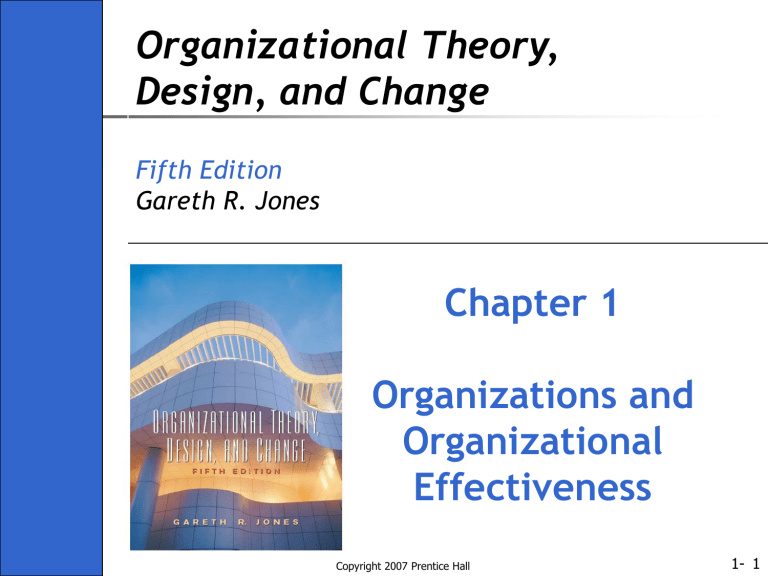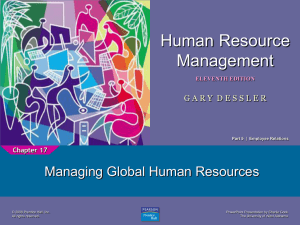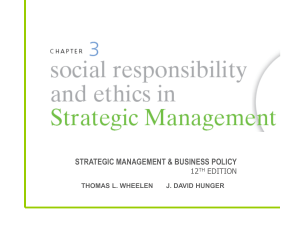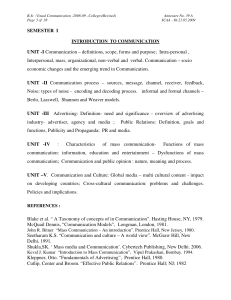
Organizational Theory, Design, and Change Fifth Edition Gareth R. Jones Chapter 1 Organizations and Organizational Effectiveness Copyright 2007 Prentice Hall 1- 1 Learning Objectives 1. Explain why organizations exist and the purposes they serve 2. Describe the relationship between organizational theory and organizational design and change, and differentiate between organizational structure and culture Copyright 2007 Prentice Hall 1- 2 Learning Objectives (cont.) 3. Understand how managers can utilize the principles of organizational theory to design and change their organizations to increase organizational effectiveness 4. Identify the three principal ways in which managers assess and measure organizational effectiveness 5. Appreciate the way in which several contingency factors influence the design of organizations 1- 3 Copyright 2007 Prentice Hall What is an Organization? Organization: a tool used by people to coordinate their actions to obtain something they desire or value Entrepreneurship: the process by which people recognize opportunities to satisfy needs, and then gather and use resources to meet those needs Copyright 2007 Prentice Hall 1- 4 How Does an Organization Create Value? Value creation takes place at three stages: input, conversion and output Inputs: include human resources, information and knowledge, raw materials, money and capital Conversion: the way the organization uses human resources and technology to transform inputs into outputs Output: finished products and services that the organization releases to its environment Copyright 2007 Prentice Hall 1- 5 Figure 1 – 1: How An Organization Creates Value Copyright 2007 Prentice Hall 1- 6 Why Do Organizations Exist? To increase specialization and the division of labor To use large-scale technology Economies of scale: cost savings that result when goods and services are produced in large volume Economies of scope: cost savings that result when an organization is able to use underutilized resources more effectively because they can be shared across several different products or tasks Copyright 2007 Prentice Hall 1- 7 Why Do Organizations Exist? (cont.) To manage the external environment Pressures from the external environment make organizations the favored mode for organizing productive resources To economize on transaction costs Transaction costs: the costs associated with negotiating, monitoring, and governing exchanges between people who must cooperate To exert power and control Copyright 2007 Prentice Hall 1- 8 Figure 1-3: Why organizations exist Copyright 2007 Prentice Hall 1- 9 Organizational Theory, Design, and Change: Some Definitions Organizational theory: the study of how organizations function and how they affect and are affected by the environment in which they operate Organizational structure: the formal system of task and authority relationships that control how people coordinate their actions and use resources to achieve organizational goals Copyright 2007 Prentice Hall 1-10 Some Definitions (cont.) Organizational culture: the set of shared values and norms that control organizational members’ interactions with each other and with suppliers, customers, and other people outside the organization Organizational design: the process by which managers select and manage aspects of structure and culture so that an organization can control the activities necessary to achieve its goals Copyright 2007 Prentice Hall 1-11 Some Definitions (cont.) Organizational change: the process by which organizations move from their present state to some desired future state to increase their effectiveness Copyright 2007 Prentice Hall 1-12 Figure 1-4: Relationships Among Organizational Theory, Structure, Culture, Design and Change Copyright 2007 Prentice Hall 1-13 Importance of Organizational Design and Change Dealing with contingencies Contingencies are events that might occur and must be planned for Gaining competitive advantage The ability to outperform other companies because of the capacity to create more value from resources Core competences: skills and abilities in value creation Strategy: pattern of decisions and actions involving core competences that produces a competitive advantage Copyright 2007 Prentice Hall 1-14 Importance of Organizational Design and Change (cont.) Managing diversity Differences in the race, gender, and national origin of organizational members have important implications for organizational culture and effectiveness Promoting efficiency, speed, and innovation The better organizations function, the more value they create Copyright 2007 Prentice Hall 1-15 Consequences of Poor Organizational Design Decline of the organization Talented employees leave to take positions in growing organizations Resources become harder to acquire Resulting crisis impels managers to change organizational structure and culture Copyright 2007 Prentice Hall 1-16 How Do Managers Measure Organizational Effectiveness? Control: external resource approach Method evaluates how effectively an organization manages and controls its external environment Innovation: internal system approach Method allows managers to evaluate how effectively an organization functions and operates Efficiency: technical approach Method evaluates how efficiently an organization converts a fixed amount of resources into finished goods and services Copyright 2007 Prentice Hall 1-17 Table 1-1: Approaches to Measuring Effectiveness Copyright 2007 Prentice Hall 1-18 Measuring Effectiveness: Organizational Goals Official goals: guiding principles that the organization formally states in its annual report and in other public documents Mission: goals that explain why the organization exists and what it should be doing Operative goals: specific long- and short-term goals that guide managers and employees as they perform the work of the organization Copyright 2007 Prentice Hall 1-19 Figure 1-5: Plan of the Book Copyright 2007 Prentice Hall 1-20 Figure 1-5: Plan of the Book (cont.) Copyright 2007 Prentice Hall 1-21 Figure 1-5: Plan of the Book (cont.) Copyright 2007 Prentice Hall 1-22




